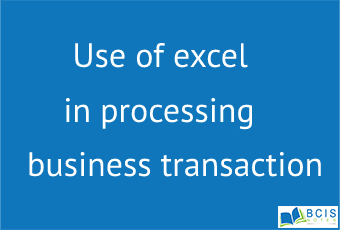
Use of excel in processing business transaction
Microsoft Excel was released in 1985 and has grown to become arguably the most important computer program in workplaces around the world. You generally would use Excel. In business, literally, any function in any industry can benefit from those with strong Excel knowledge. Excel is a powerful tool that has become entrenched in business processes worldwide, whether for analyzing stocks or issuers, budgeting, or organizing client sales lists.
7 Popular Business Uses for Microsoft Excel
- Data entry and storage. At its most basic level, Excel is an excellent tool for both data entry and storage.
- Collection and Verification of Business Data.
- Administrative and managerial duties.
- Accounting and budgeting.
- Data Analysis.
- Reporting + Visualizations.
- Forecasting.
Businesses often use Excel, a Microsoft spreadsheet application often installed by default as part of the Microsoft Office suite on business computers. Excel workbooks contain individual worksheets, which you can use to create lists and spreadsheets. Once you become accustomed to the application and familiar with the more powerful functions available, you’ll find many uses for this business tool.
Scheduling
Businesses create basic employee and resource schedules with Excel that can be color-coded and designed to automatically update as the schedules change. Create weekly worksheets with column headings of each day, and name the rows based on hourly slots or work shifts. Fill in each slot with the employee or resource name for a given day. A conference room resource schedule sheet may have Monday from 9 a.m. to 10 a.m. marked for an executive meeting for example, while Tuesday from 10 a.m. to 11 a.m. is reserved for a conference call. All departments can work from the same resource sheet so that everyone knows when a given resource is available for use.
Basic Accounting
Small businesses often use Excel as a basic accounting program or checkbook ledger. You can enter deposits and expenditures onto each row of the sheet as you would enter them into a check register. One of the benefits of using Excel in this fashion is that you can create charts and graphs over time to compare business income and expenditures.
Product Sales
Track product sales using it on a daily, weekly, monthly or quarterly basis. Collecting the sales data onto an Excel spreadsheet lets you compare progress over time, and spot upward or downward trends as they occur.
According to Microsoft, once you have a meaningful amount of sales data tracked, you can then forecast sales for the next year.
Return On Investment
Tracking total business sales in dollars along with total advertising and marketing expenditures with Excel allows you to see your Return on Investment for each campaign. If you know you normally sell 100 units of a product each week at $20 profit each and you launch an advertising campaign that costs $2,000 for one week, you’ll need to see an additional 100 product sales to break even on that campaign. If you’re tracking the sales, you’ll be able to see how long it takes you to reach break even or additional profit levels from an ad campaign.
You may also like Objectives and preparation of trial balance

Leave a Reply